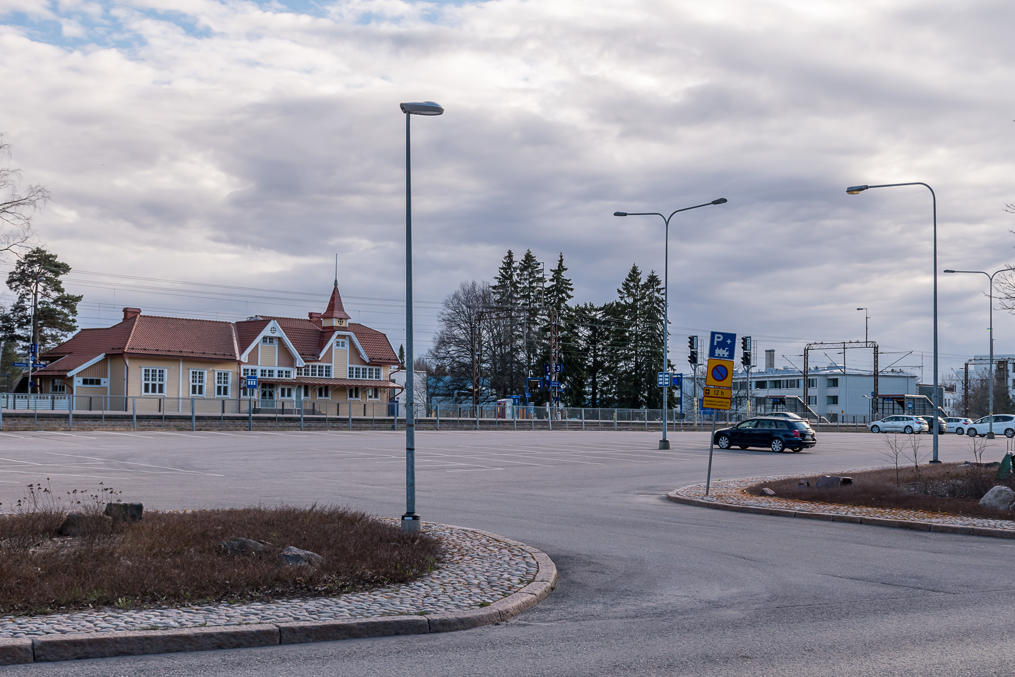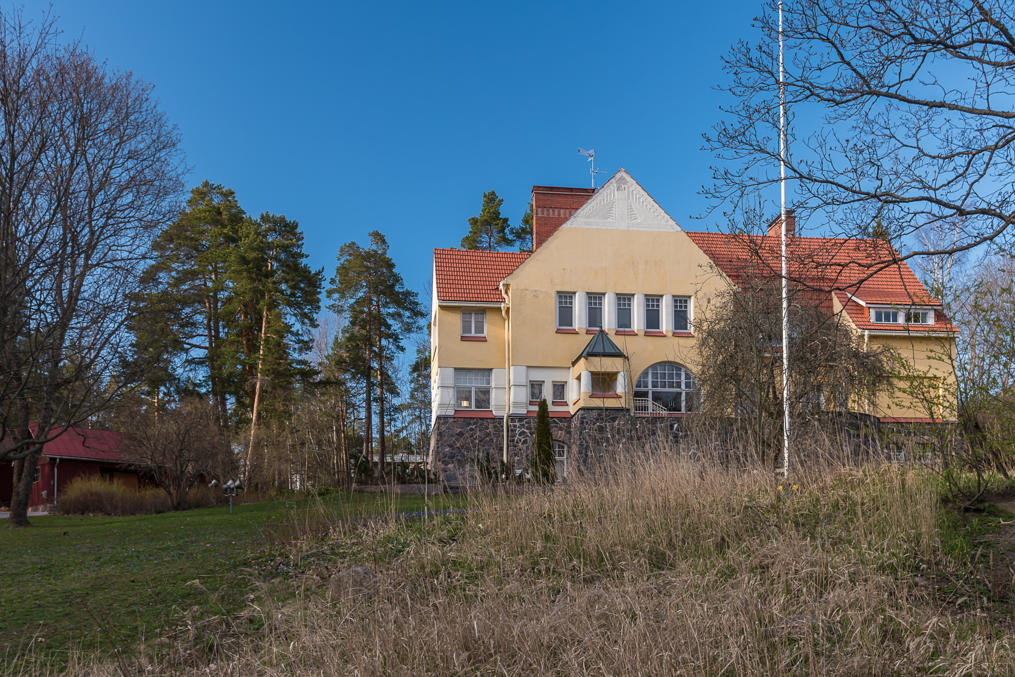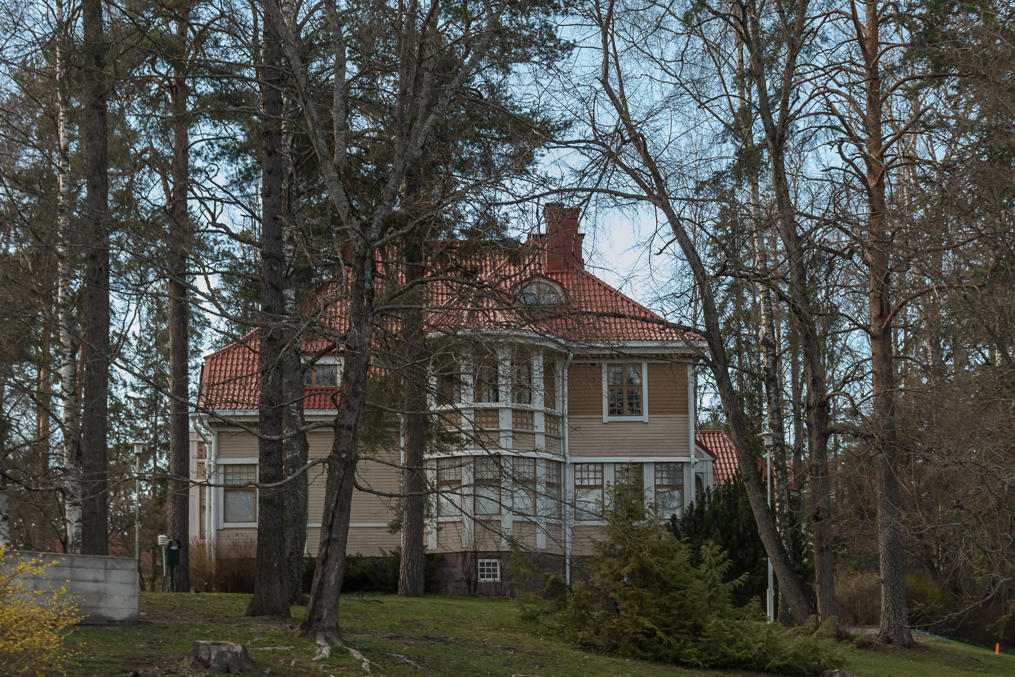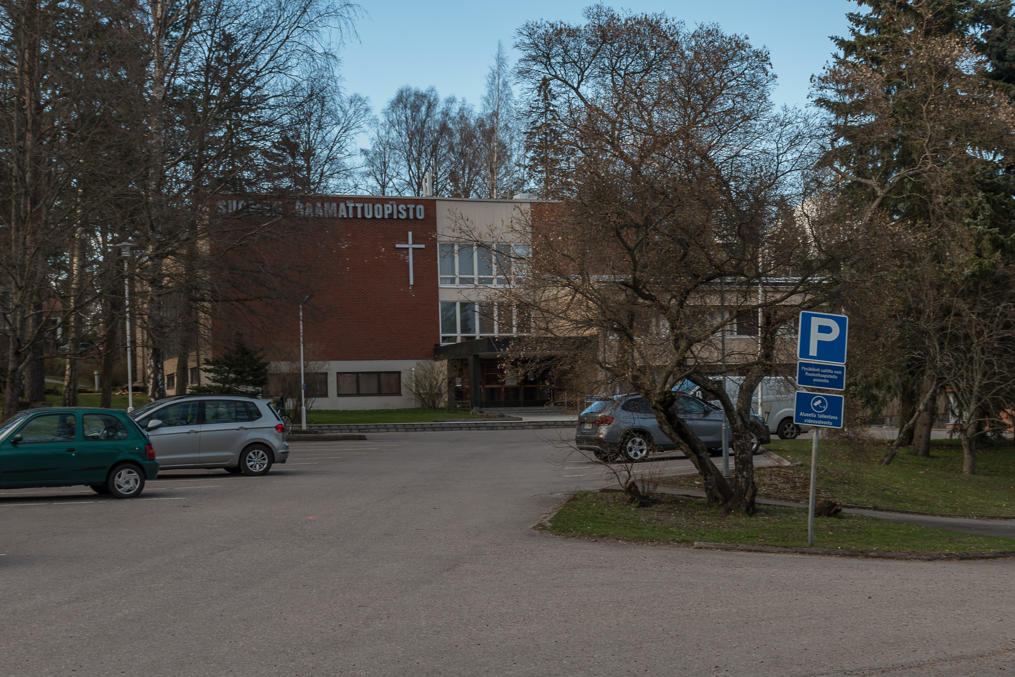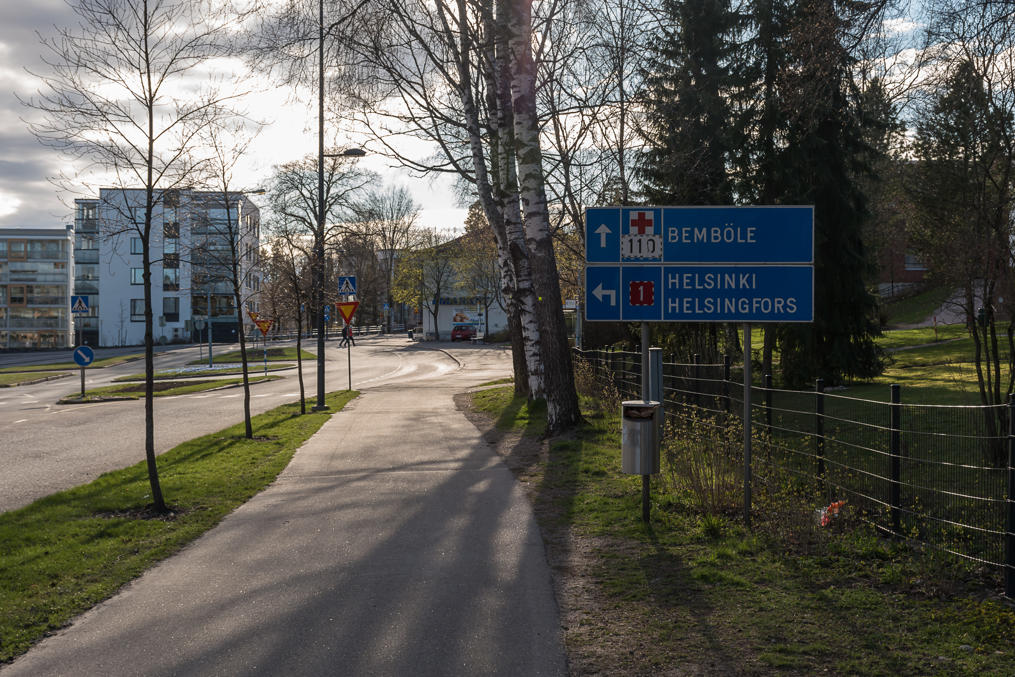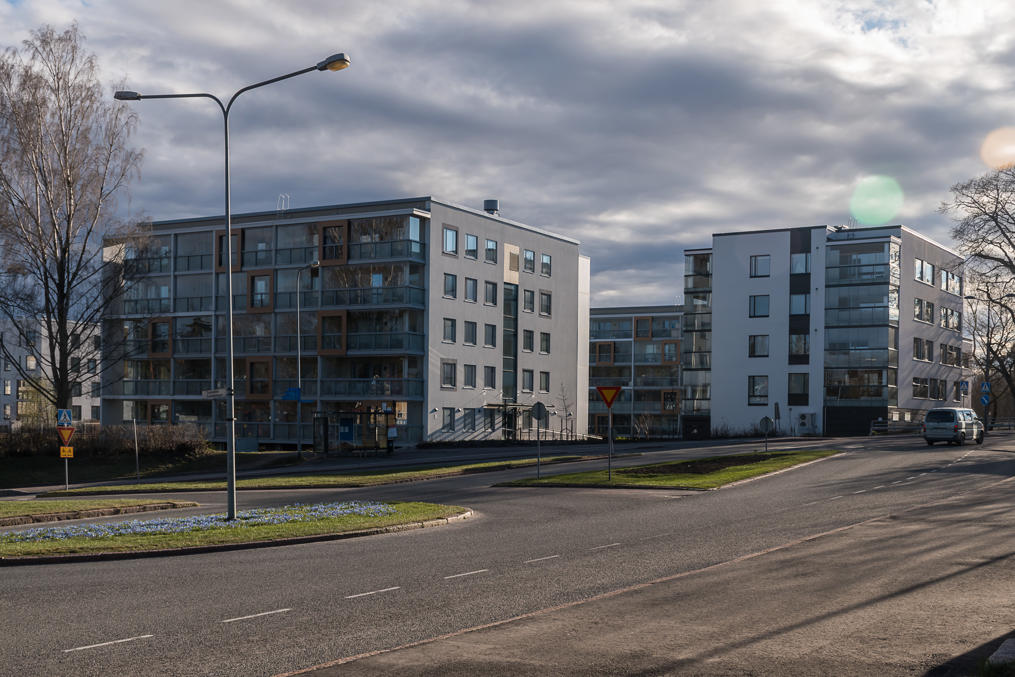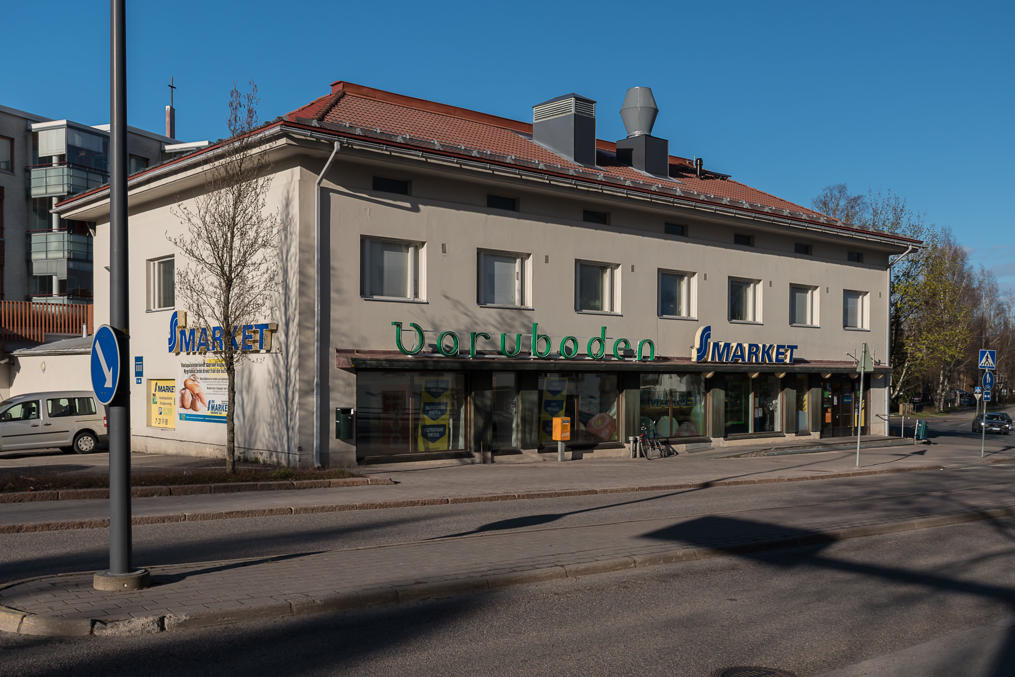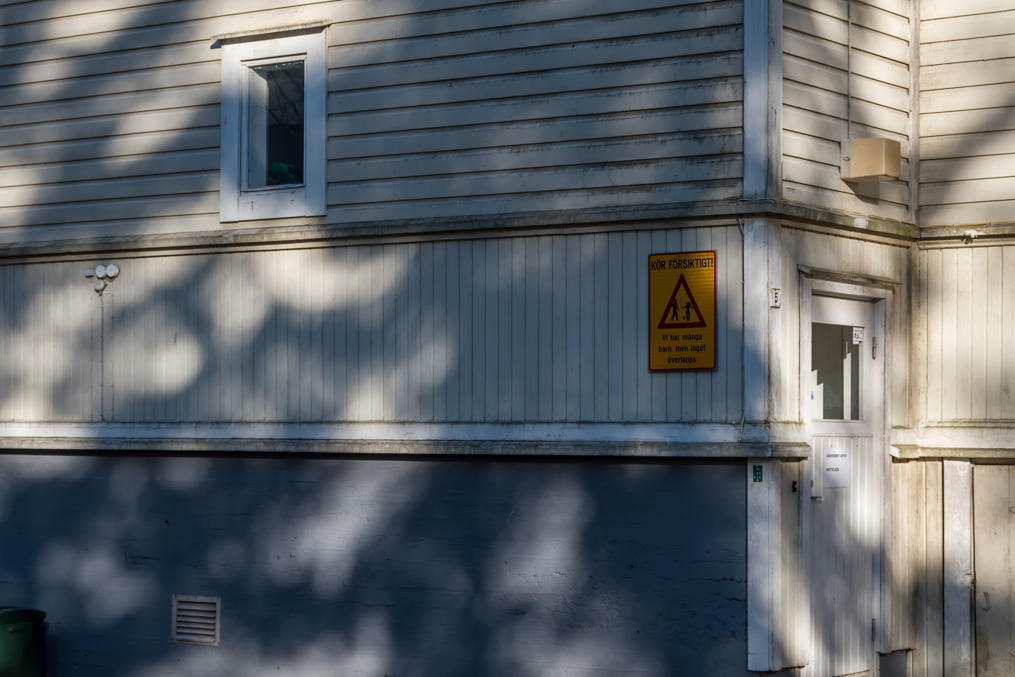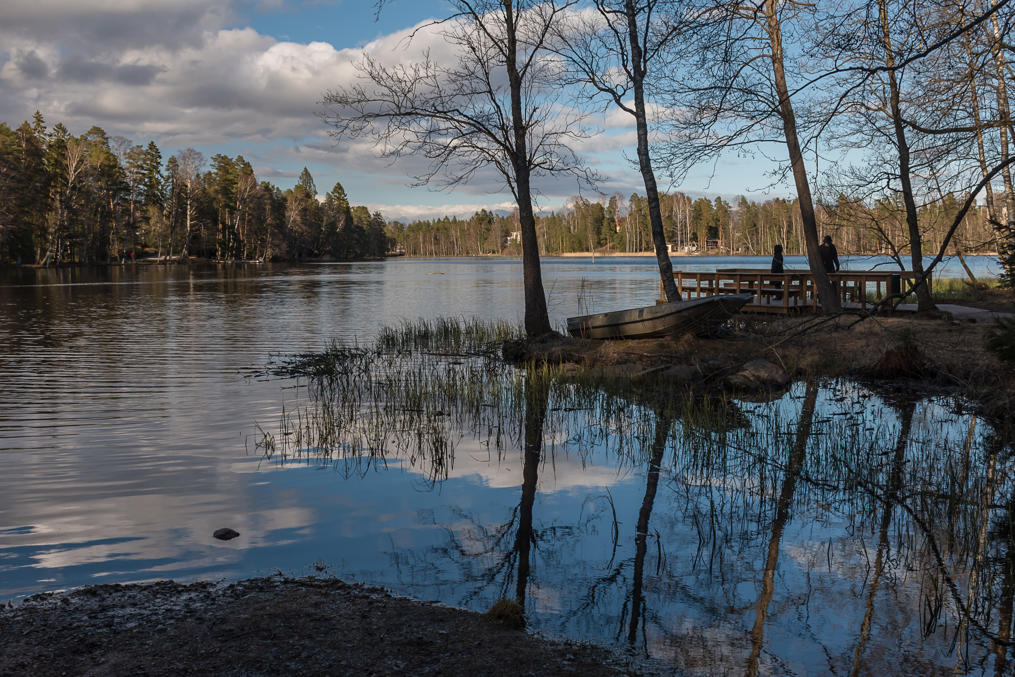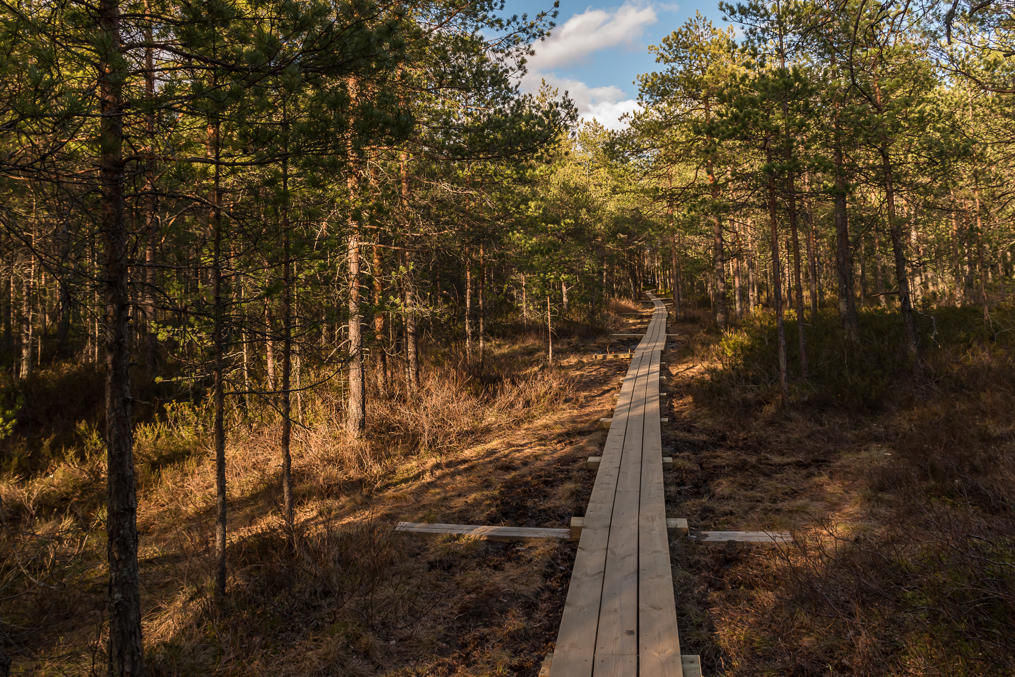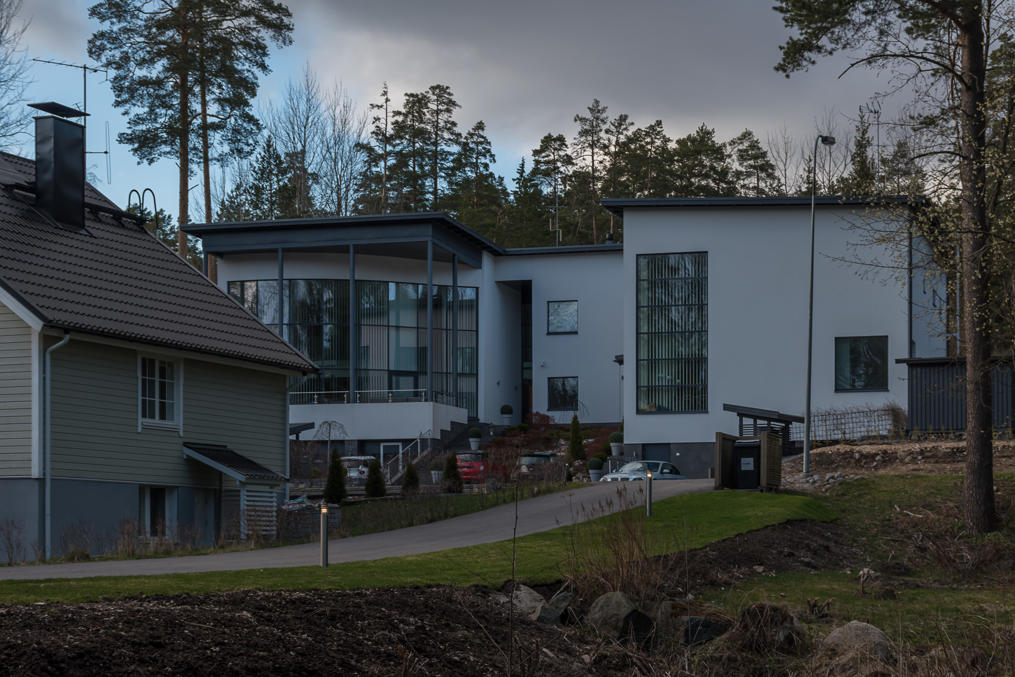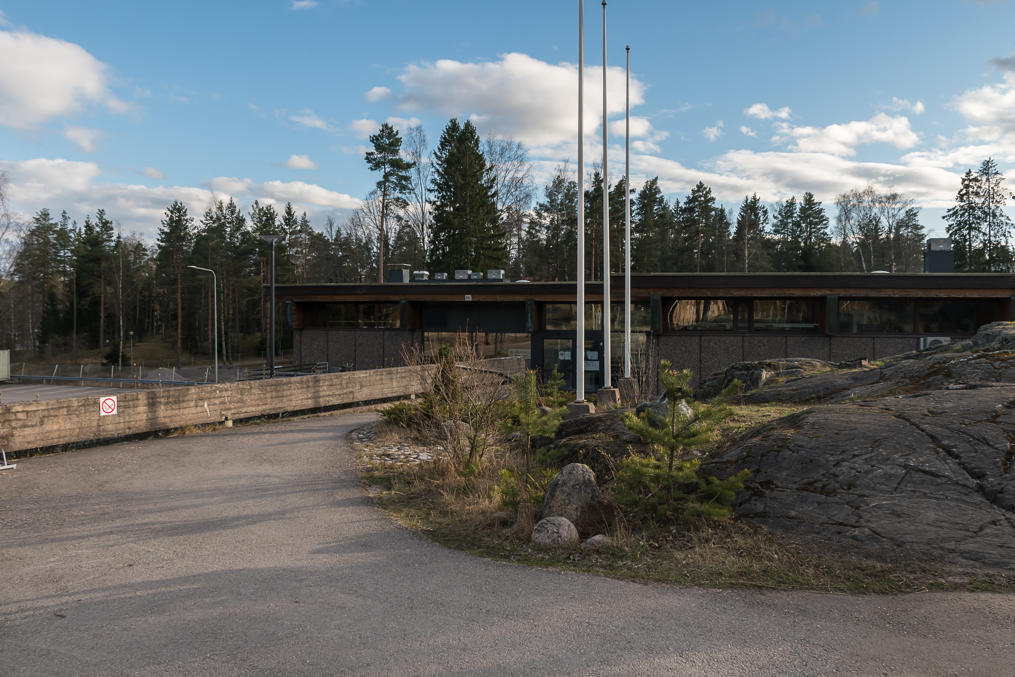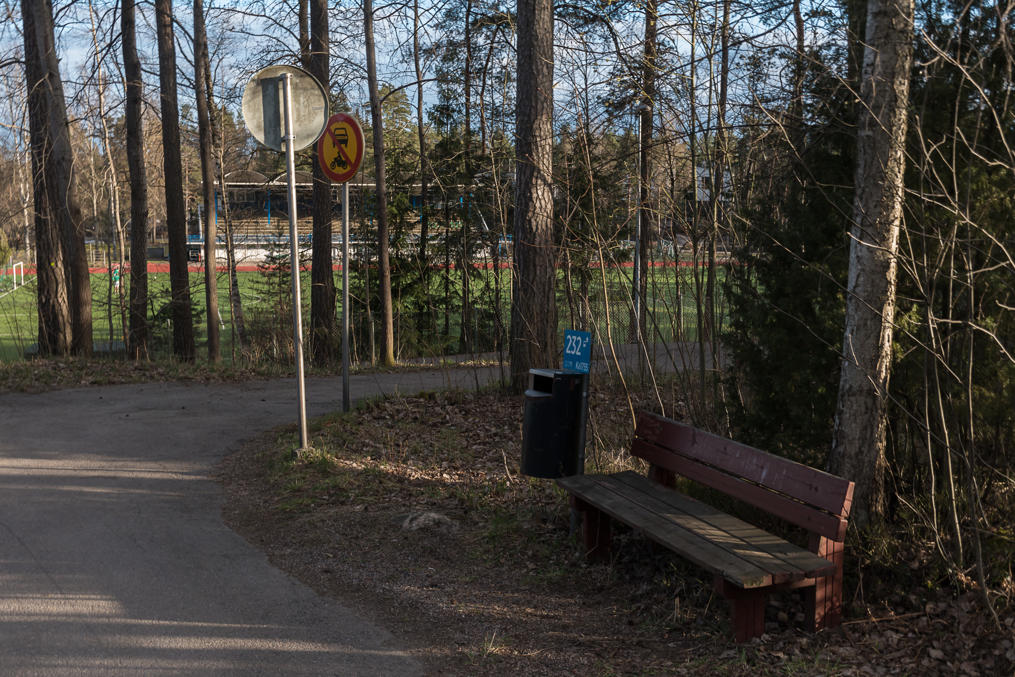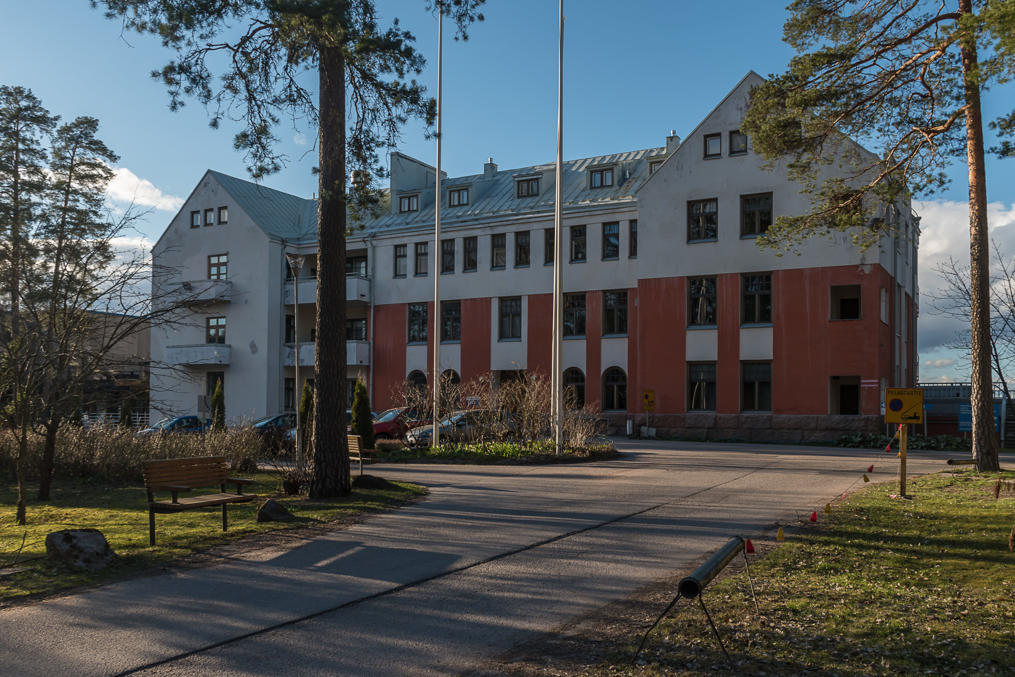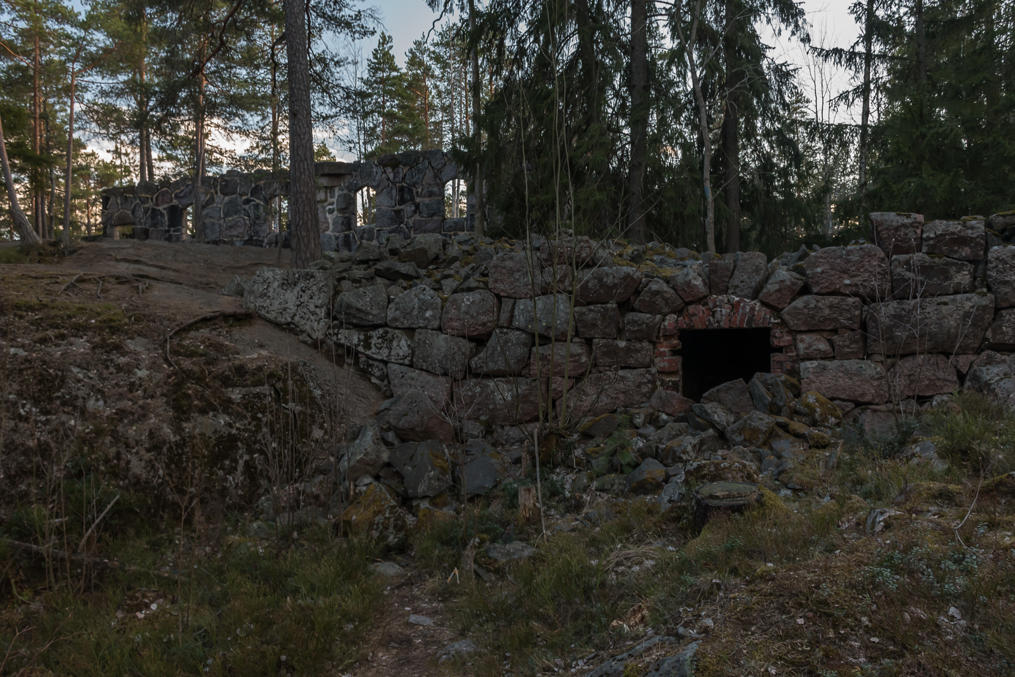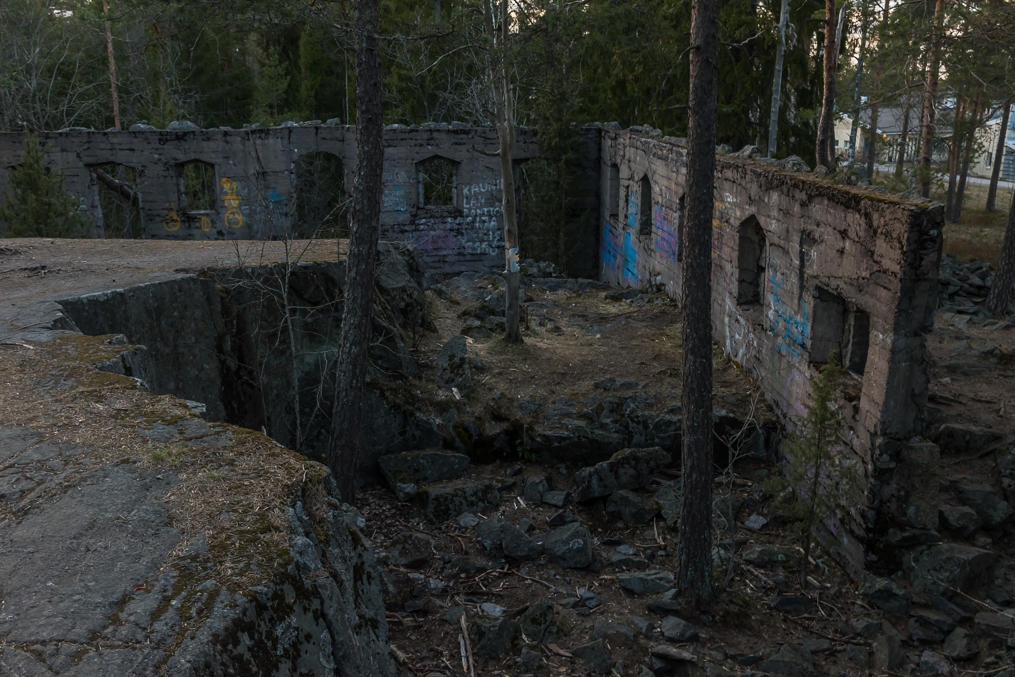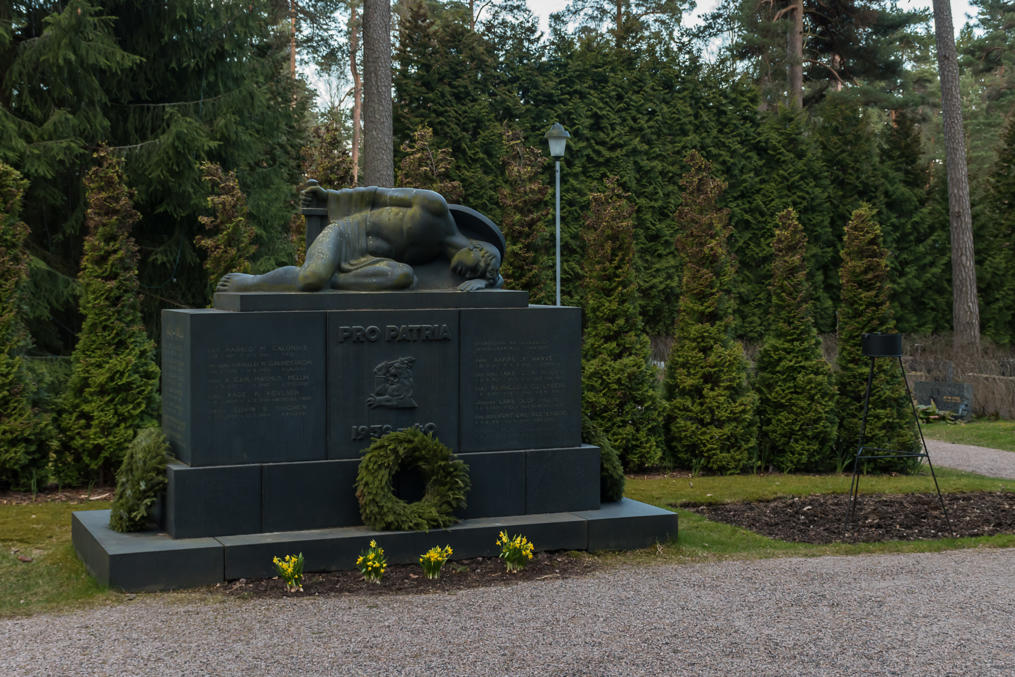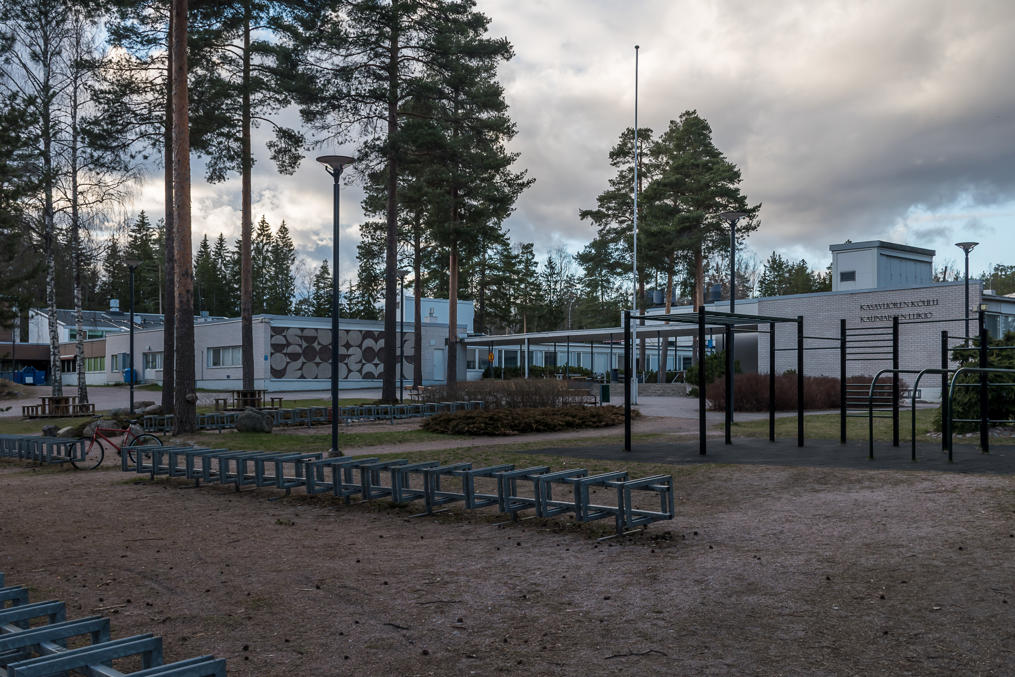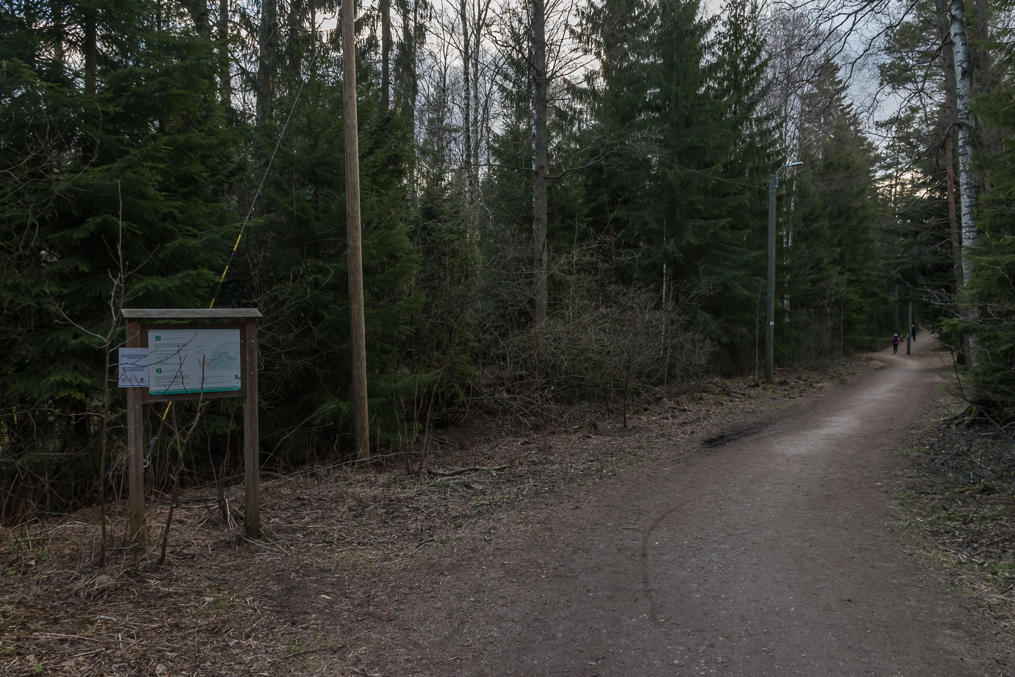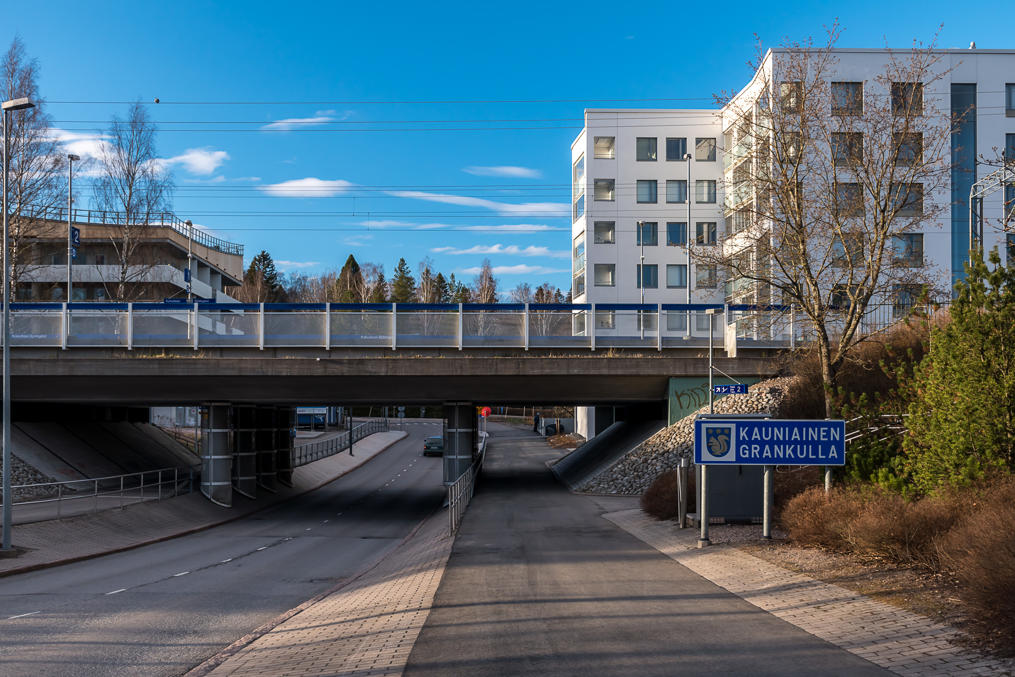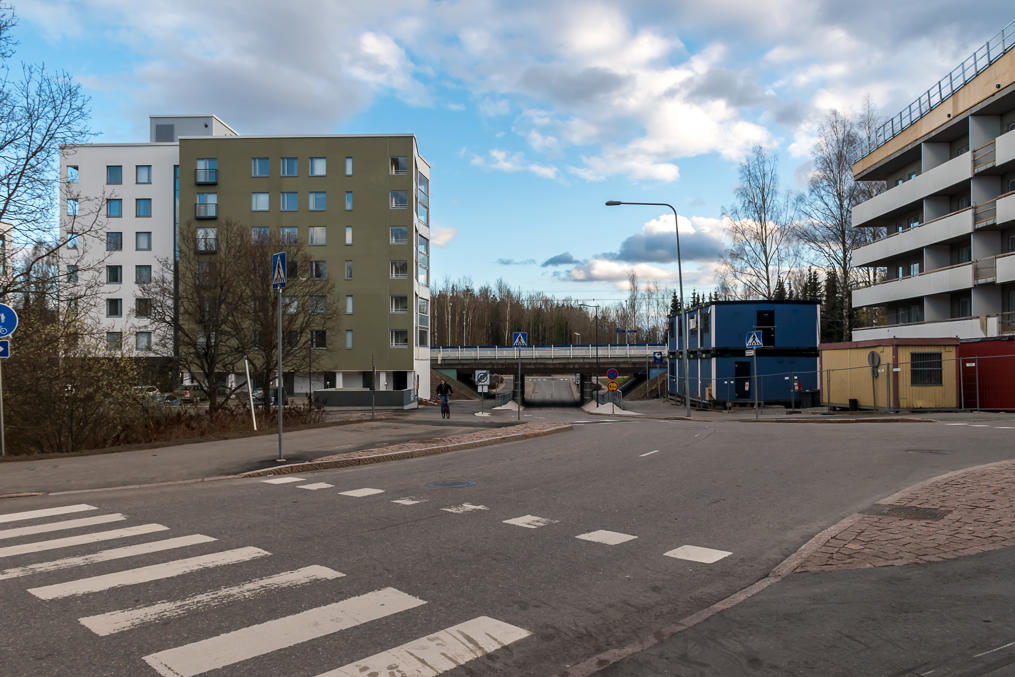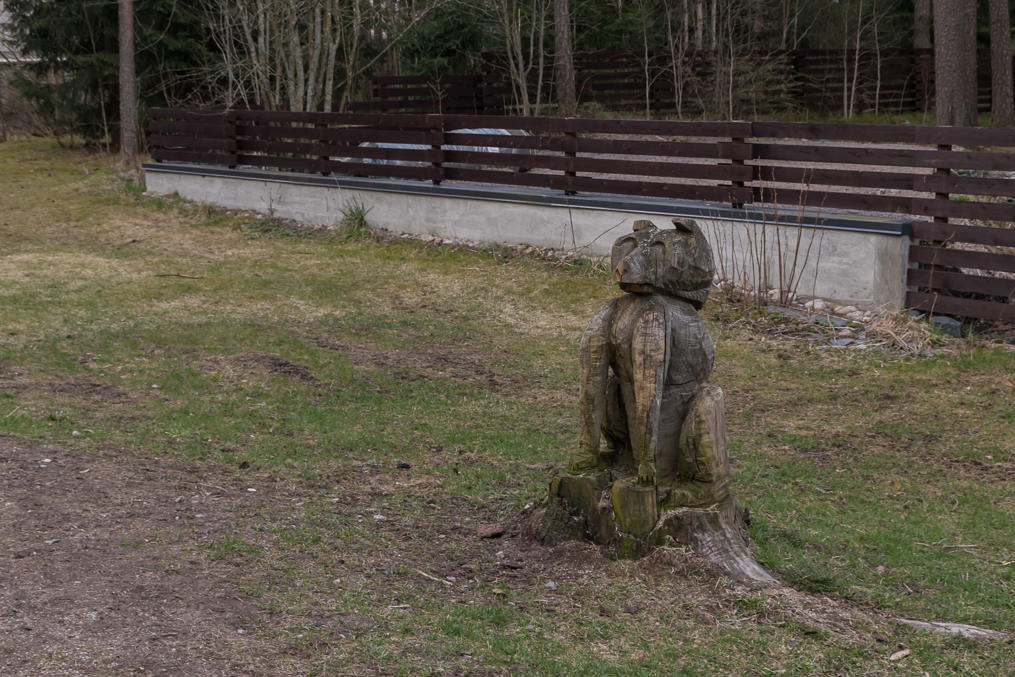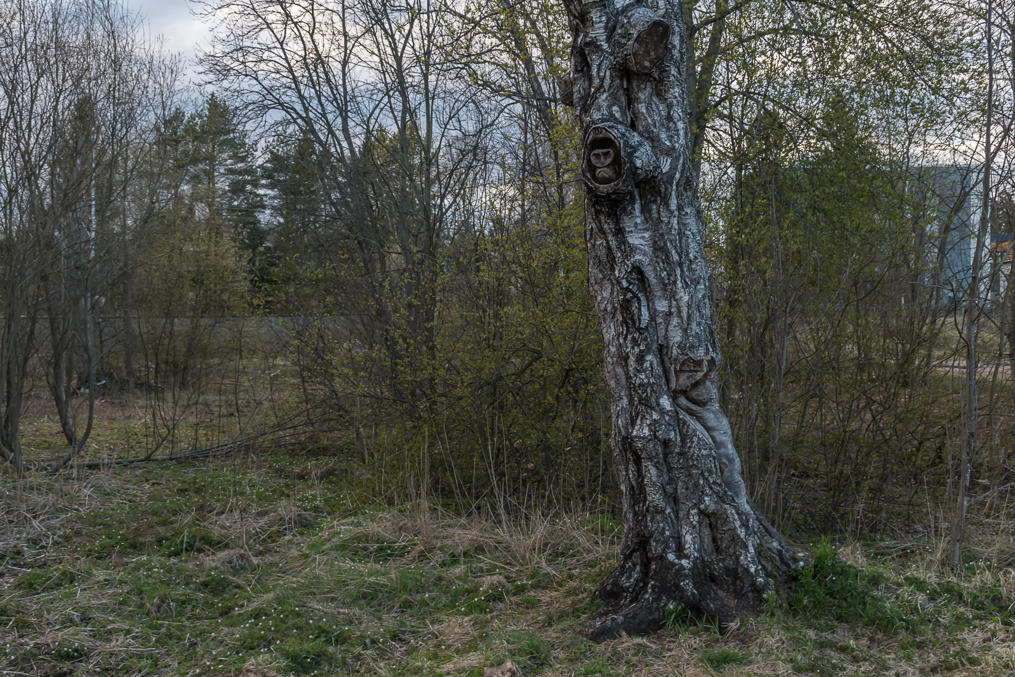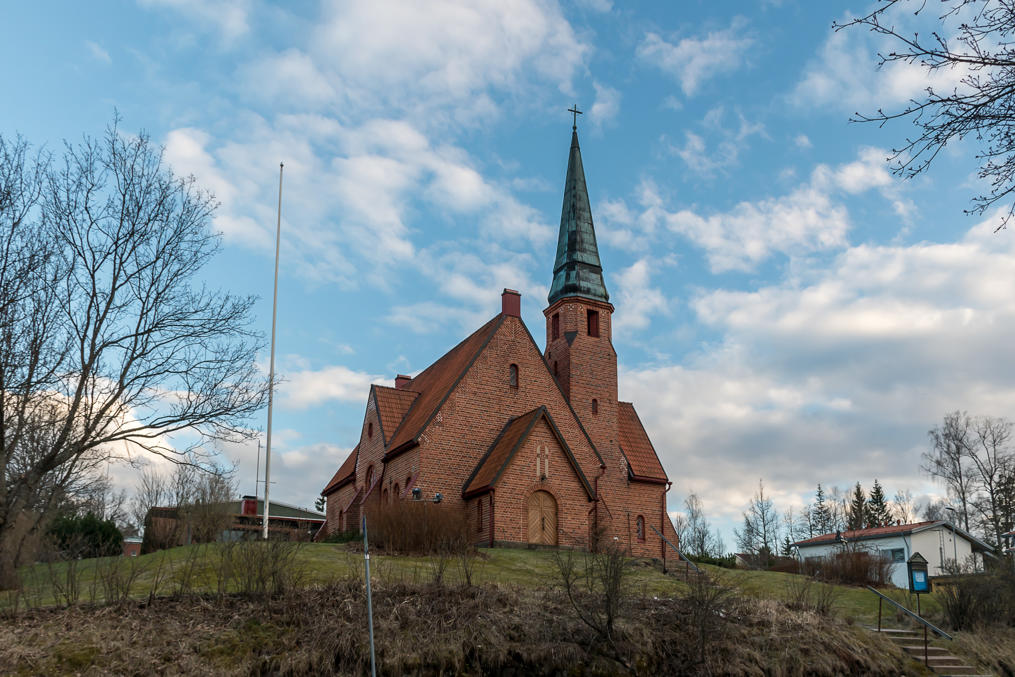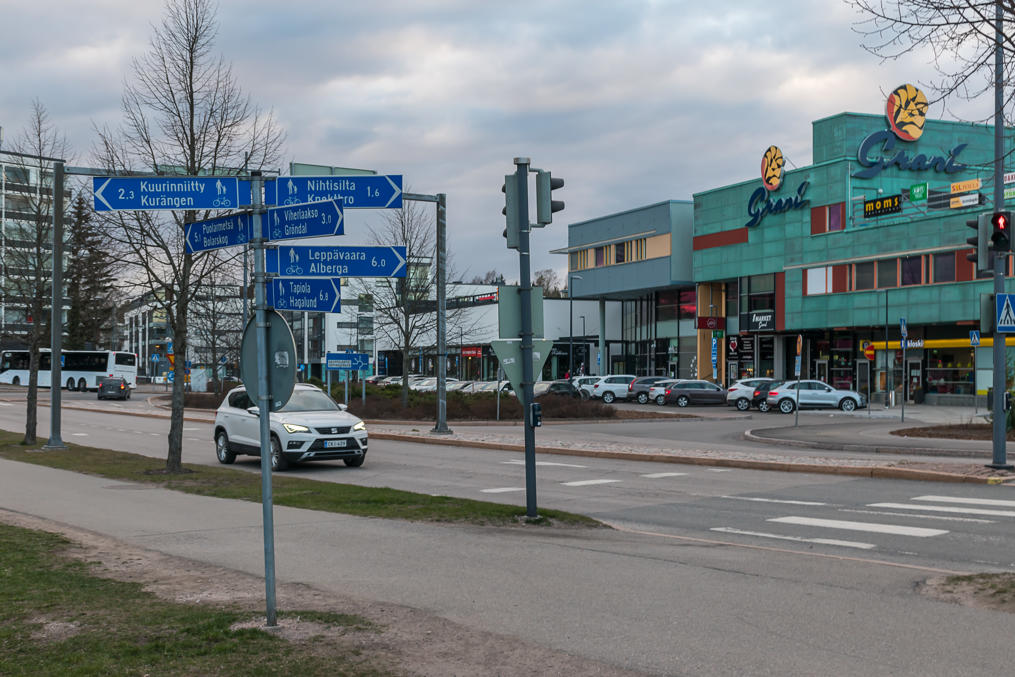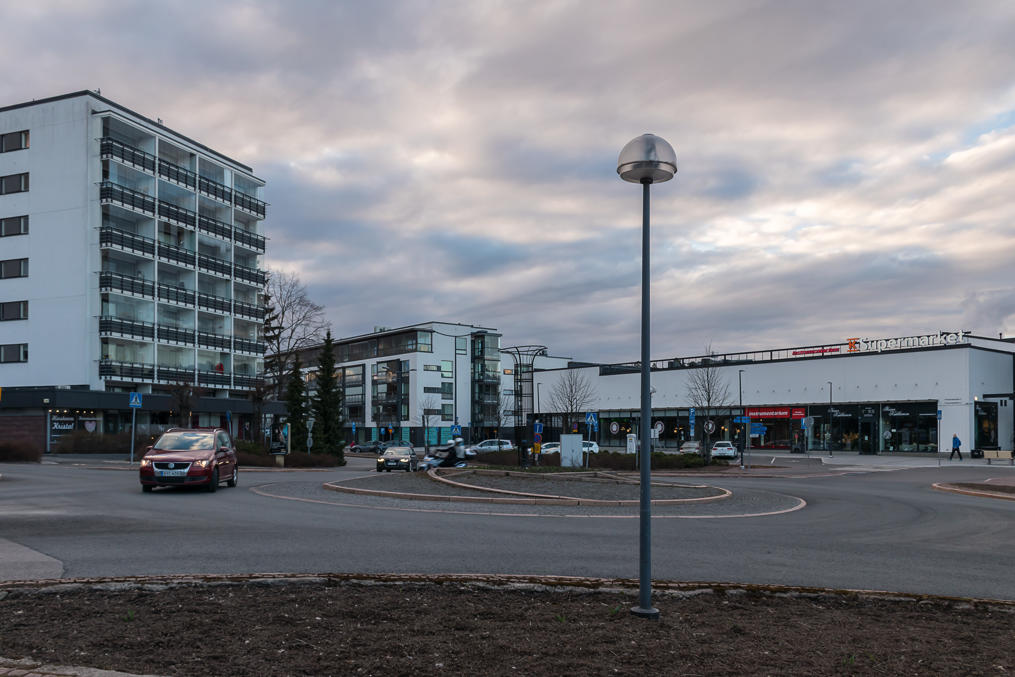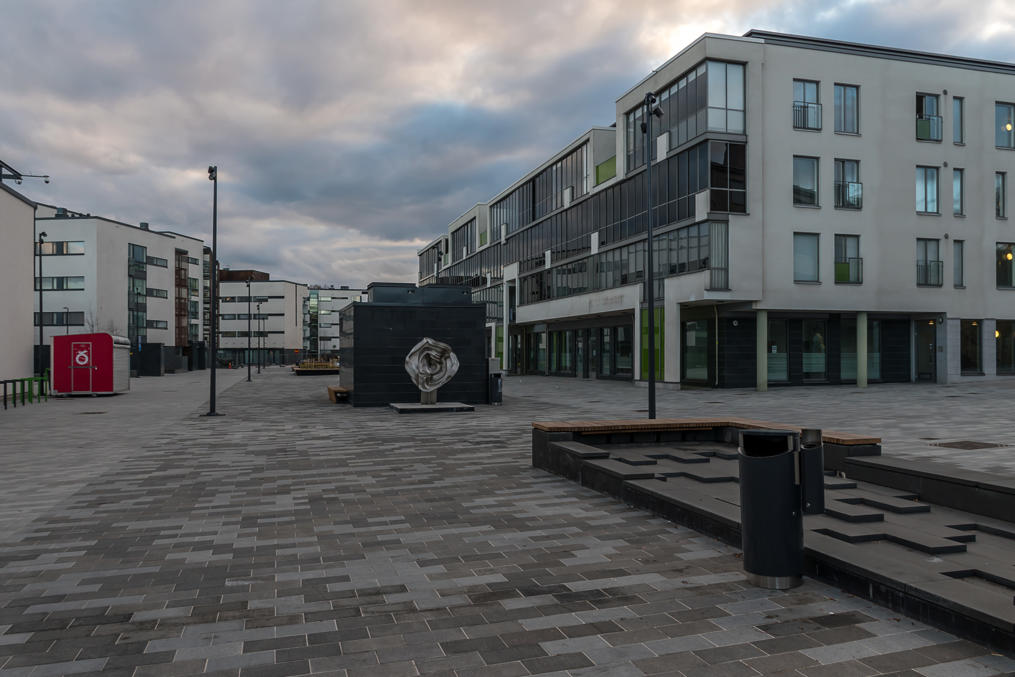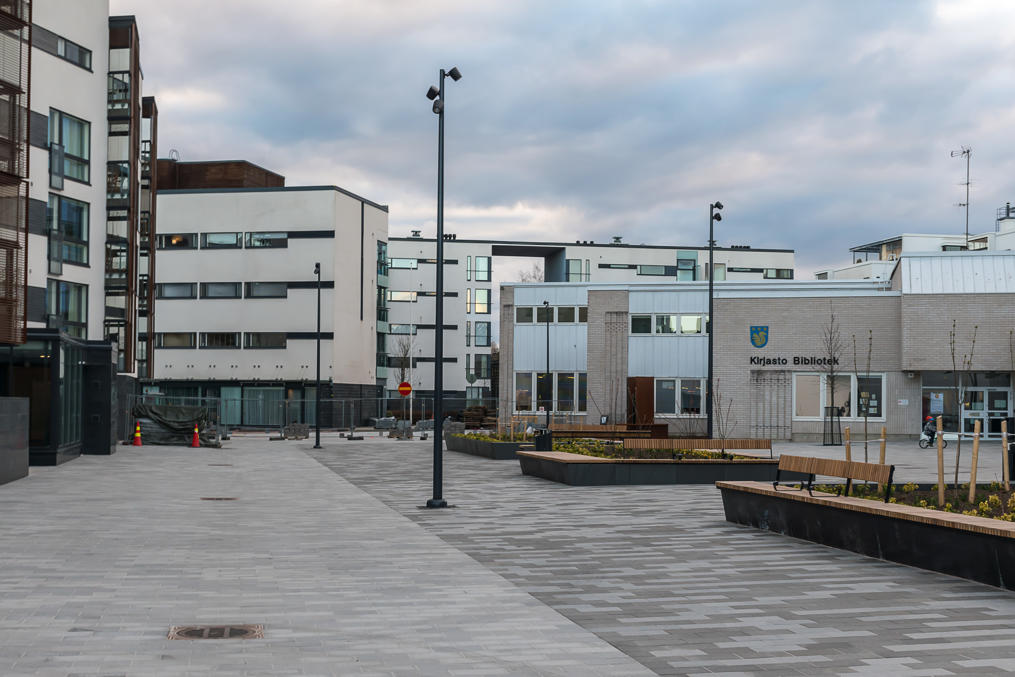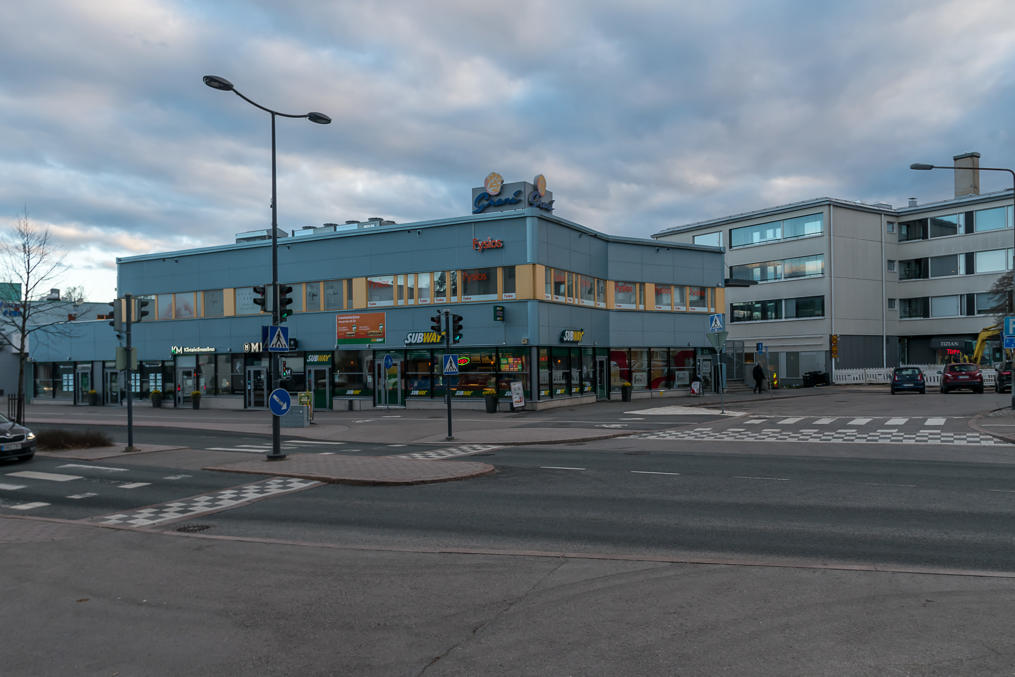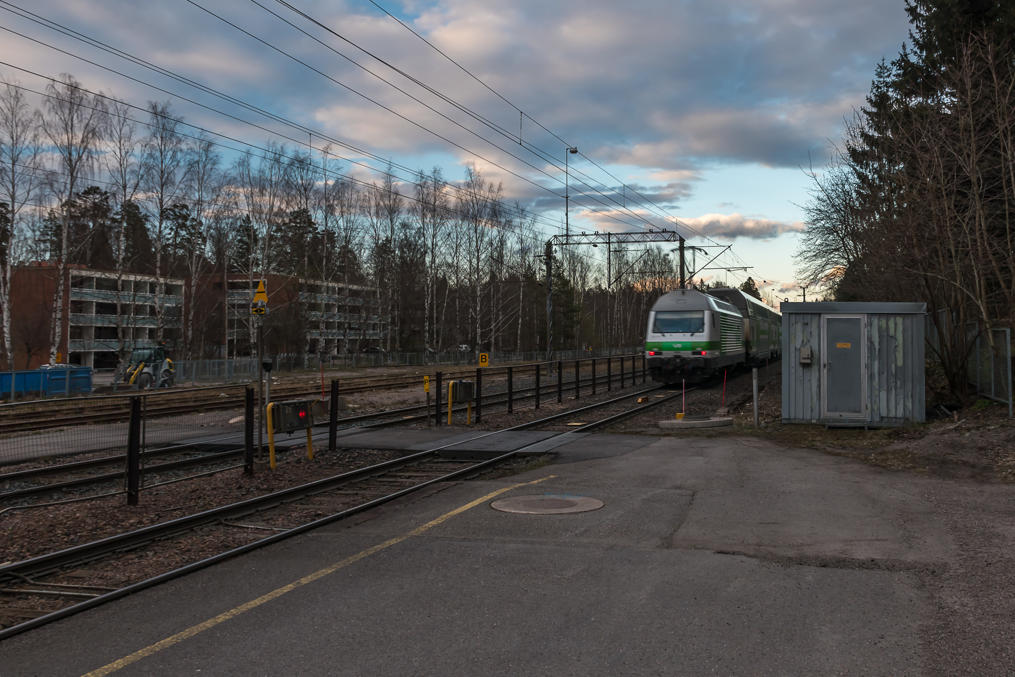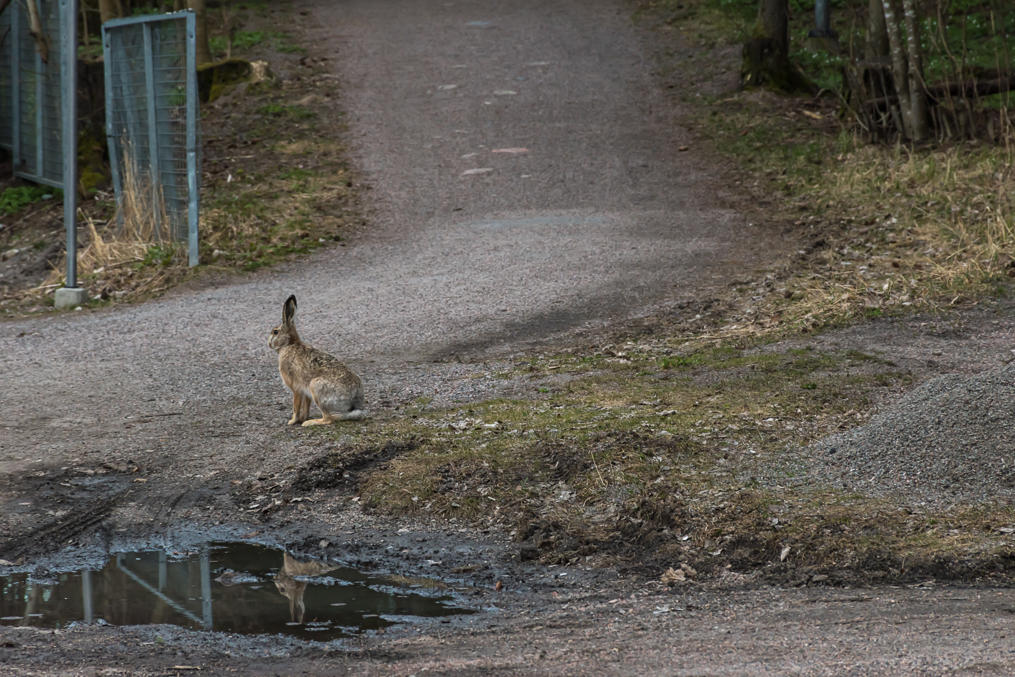Among abbreviations that every foreigner soon learns when moving to Finland is PKS, or pk-seutu, which means pääkaupunkiseutu — the Capital Region. This in truth refers more to an urban area than a region: the city of Helsinki and its satellite cities of Espoo and Vantaa, 1.2 million in population in total. Both Espoo and Vantaa are in practice just loose agglomerations of mostly residential low to middle density areas, with no single clear center and no clear border with Helsinki or each other, and not much of an identity even. They aren't even signposted on road signs; it's always either Helsinki or just a specific city area like Matinkylä. They are really the only "cities" of such kind in Finland. Yet they still are completely independent municipalities, with own city councils, budgets, city plans etc., and at this point they have no plans to ever merge with Helsinki.
The pk-seutu however includes one more city, and its name is Kauniainen, from the word kaunis meaning "beautiful", or in Swedish Grankulla, meaning "spruce hill"; the Swedish name is the original one, and often affectionately abbreviated to "Grani" even in Finnish. One could be excused for not knowing of Kauniainen's existence, as it is, unlike the other three cities, quite small: only 9800 residents. And small not only by population, but by area too; at 6 sq. km, this is the smallest Finnish municipality by area. It is an enclave of Espoo, located there along the railroad between Espoon Keskus and Kilo areas, measuring 4x2 km at the widest.
For most practical purposes Kauniainen can be considered just one of the Espoo city areas, a rather minor one at that. Yet due to a quirk of history it is legally an independent city. Kauniainen is traditionally thought of as a rich Swedish-speaking area, which has some truth to it; it has a large fraction of Swedish-speaking residents (34%), and it is indeed rather well-off, although there are also some fairly ordinary older apartment block streets there, and it is not the richest place in Finland in general (that honor would go to Westend, an area of huge villas in the southeast of Espoo).
The well-known fact about Kauniainen that it has the lowest taxes in Finland is completely true though. Finnish municipalities (both cities and rural municipalities) have the right to set their own rates for property taxes and for the municipal share of the income tax. In practice the pattern seen almost universally is that, as of 2020, Helsinki has pretty much the lowest tax rate (18% for income tax), other major cities have it at about 20-21%, and small cities and rural municipalities can jack it up to as much as 23.5%(*). The reason for that is quite simple; high earners naturally tend to flock to bigger cities, and small places need to tax their poorer populations higher to maintain the same set of government-mandated services. A few rural places do try to keep their tax at lower level to try to remain an attractive place to live, but I don't really know if that actually works for them.
(*) While the state share of the income tax has progressive tax brackets, the municipal share is technically a flat rate tax. In practice however there is an automatically applied deduction inversely proportional to taxpayer's total income, so the municipal share of income tax also acts like a progressive tax to some extent. Nonetheless for low to mid-earners, the bulk of income tax they pay will go to the municipal share.
Kauniainen however not only has a relatively well-off population, but is also just very small, and, as such, it doesn't have too much infrastructure to support; no remote villages and farms with a few stubborn old guys living on them despite anything. As such it can afford to keep its income tax rate at 17%, or 1 percentage point lower than Helsinki and Espoo. Thus it might actually be advantageable for someone to choose Kauniainen as their place of residence instead of Espoo (although it might not be so easy in practice, as there is simply not that much housing stock there available for sale or rent). Well, in truth, in latest years Kauniainen has not had a particularly great economy (like virtually every other municipality in the country; lack of structural reforms in that area has been a huge problem), and is running a deficit now, but I'm pretty sure it will still try to keep their trademark lowest tax at all costs.
The reason why Kauniainen still exists is that it basically appeared earlier than Espoo (in the latter's present shape). Up until the 1950s Espoo was a nearly completely rural municipality, with a few villages, manors and the namesake central church village (of which its medieval stone church still exists), a population of less than 10,000, and not much really reminding of its closeness to Helsinki. Kauniainen, or back then just Grankulla, appeared originally as a small private villa community between the Turku railroad and the old Turku road, officially taking beginning in 1906, when a few investors bought a large plot of land in that area, and began splitting and selling it for villas, and building infrastructure. Villa plots were pretty big, a hectare or more, and the whole thing was of course meant for rich people, and many villas were really beautiful, built by the best Finnish architects.
In 1915 Grankulla become a taajaväkinen yhdyskunta, which means something like "dense-populated community". This status was formerly used in Finland for certain town-like settlements within otherwise rural municipalities, giving these settlements limited self-governing rights; a municipality within a municipality, of sorts. By that time Grankulla had a railway station, a police precinct, a school and quite a bit of other infrastracture; as of 1917, 1647 people lived in it, presumably no longer just rich villa owners. In 1920 it became a kauppala (market town), becoming fully independent of Espoo. Throughout the 1920-30s Grankulla kept a quite different character from the rest of Espoo, which at that time started to assume the role of a Helsinki suburb, if quite slowly at first. Among other things, Grankulla refused to build any industry, striving to preserve its overall idyllic character. While Grankulla originally was a Swedish-speaking place (like Espoo itself was back in the day), by the 1930s enough Finnish-speaking people lived there that it became officially bilingual and adopted the Kauniainen name, taken from one of the villas.
The existence of Kauniainen was threatened after the war, because it clearly was getting too small to keep with municipality responsibilities; it was running out of space for new residents, basically. At the same time the explosive growth of Espoo as a suburb of Helsinki started, originally with areas closest to Helsinki; the "garden town" of Tapiola and the University of Technology (nowadays Aalto University) at Otaniemi were being established in southeastern Espoo, and from the 1950s to these days Espoo has been growing at a surprisingly steady rate of 30,000-40,000 new residents per decade. Even areas close to Kauniainen such as Viherlaakso started growing much faster than the villa town. In the end Kauniainen was forced to adapt to the realities, adopting a new town plan, allowing for some villas to give way to apartment block construction. Some more land was also joined to it from Espoo. In 1972 Kauniainen became a full city, like all the remaining market towns did in that decade.
In this shape Kauniainen exists to this day, with beatiful old villas and more modest residential areas, and still with no industry and little to none commercial activity. Still it remains a surprisingly complete and cohesive-looking town; you wouldn't really even know you're actually deep within Espoo, it looks more like a completely standalone small Finnish town, just somehow transplanted into this place. Although mostly built-up, it even preserves some nature, including a lake (600x250 m large), a few mires, and a relatively prominent hill, Kasavuori, rising about 50 m over the landscape, with its steepest rocky southwestern slopes these days overlooking the Turunväylä (Finn. Turku Thoroughfare) motorway. I really wouldn't mind living in Kauniainen myself, and not just for tax reasons; it's probably one of the nicest places in all pk-seutu, at least in my view (I just love small towns).
In principle Kauniainen is not the only such "city within a city" place in the pk-seutu. Helsinki, before the 20th century limited to its central peninsula, has expanded its area many times (last time in 2009), and the greatest such expansion came in 1946, where Helsinki area increased five times and it subsumed most of its then-suburbs, which had been growing around it in a somewhat haphazard fashion. These suburbs mostly belonged to the Helsinki rural municipality (which eventually turned into Vantaa), but a few had already been independent for decades: Huopalahti, Haaga, Oulunkylä and Kulosaari. These former towns, with the possible exception of Kulosaari, have also mostly preserved their old centers and still have a "city within a city" look to some extent.
These days I happen to live in Espoo fairly close to Kauniainen, in Kilo, 4 km and two train stations away from it. Although I had a few walks there before, pictures in this post are from a single walk this spring, in late April. I walked there from home one evening after work, making this probably the only time in my life I could actually nearly completely explore a city in an evening by just walking there from my home after work. The only places of interest left out are the Kasavuori hill and the skiing slopes (yes believe it or now Kauniainen also even has skiing slopes on another hill).
1. Let's start and end with the railway station. Trains first started to stop at this place, on the Coast Railroad (Rantarata) Helsinki-Turku, in 16 km from the Helsinki central station, in 1904. The wooden station building was built in 1908 by Bruno Granholm (1857-1930), same person who designed many other wooden railway stations all over Finland, and around the same time the stop was expanded into a proper station with multiple tracks. Freight tracks still haven't been demolished here, even though of course no one is going to ship here anything by train now, and overall the entire Helsinki-Karis section of this railroad never has any freight trains at all.
The station building was nearly destroyed in a fire in 2008, but was completely rebuilt and restored to its original appearance. The building however as far as I know is not actually used at all at the moment. Only commuter trains (E and U routes) stop at the station, every 15 minutes normally, so there's no real need even for a waiting room. Trains reach Helsinki central station from Kauniainen in 18 minutes.
We're currently looking at the station from the northern side, and in the foreground is a large park-and-ride parking lot (free and limited to 12 hours). It's not always quite as empty as in the picture (the pictures, among other things, were taken during coronavirus restrictions times), in fact, it can often be completely full, because Kauniainen's two stations are the last ones in the B tariff zone; farther stations are in the C zone, and travel from there to Helsinki is considerably more expensive. Thus quite a few people living in farther parts of Espoo poorly served by public transport might prefer to choose Kauniainen specifically, to drive there and leave their car for a day and continue by train, rather than a station that might actually be closer to their home.
2. The villa part of Kauniainen begins north of the railroad and stretches to Gallträsk lake, but we won't really see many villas this time. This is Villa Vallmogård, one of the most prominent ones, designed by Lars Sonck and built in 1907 for Mikael Lybeck, a Finnish-Swedish writer. The building is now owned by the city and used for a music school and for concerts and events.
3. Villa Tusculum from 1908 is now used by the Bible Institute.
4. The main building of the Finnish Bible Institute (Suomen Raamattuopisto) is more modern and modest. The institute was founded in 1939 as a part of the so-called Fifth Revival or neo-pietist movement, another period of increased interest in living one's life closer to God's will and in encouraging each other to do that. (The fourth and probaly the best known such movement in Finland was the somewhat infamous Laestadianism.) The revival movements have nearly all still been a part of the overall Evangelical Lutheran Church of Finland, as opposed to being some independent sects. The Bible Institute operates to, well, teach Bible to everyone who wishes to learn. This is the central institute of the country that does that, but its representatives work in many other parishes, so it's not like you must come to Kauniainen if you want to learn the Bible.
(As an aside, it's interesting how in Finnish language the word "Bible" sounds unlike in most other languages: raamattu. Yet it is rather obviously similar to the Russian грамота ("gramota"; dropping first consonants in loanwords if the original word started with multiple consontants is very common in Finnish), meaning "writing" or "knowledge" and itself a loanword from Greek. From Russian this word came to Finnish and Estonian languages, although in Estonian it just means "book" in general.)
5. The church, right across the railway station. Surprisingly enough this is not a replacement of some older burned down church, but actually the original church of Kauniainen; it got its own parish only in 1978, and the church was built in 1983, designed by Kristian Gullichsen (b. 1932), one of the most prominent Finnish modernist architects of the late 20th century. It's not a bad looking church but certainly wouldn't be what first comes into mind when you hear the word "church".
6. One of Kauniainen's main streets. Since this is an independent city and all, signs for Helsinki and Bemböle (Espoo area) have a blue rather than white background.
7. Modern residential buildings.
8.
9. The old grocery store still keeps the Varuboden sign. The S-Group, to which S-Market, Prisma, Sale/Alepa stores and a number of other businesses belong, is not a single entity; despite unified branding, it consists of 19 functionally independent cooperatives. Of this Varuboden was the oldest, dating from 1889, and operated in bilingual areas of Western Uusimaa. In 2011 it merged with Osla that operated in bilingual areas of Eastern Uusimaa, so now it's Varuboden-Osla. The rest of the pk-seutu and also Central Uusimaa is covered by HOK-Elanto cooperative, so Varuboden-Osla stores in Kauniainen are an isolated exception. Since relatively recently Varuboden-Osla also has operated in Åland.
10. On a smaller street a whole actual cinema can be found, named Bio Grani. "Bio" for some reason means "movie" in Swedish, which also explains the name of BioRex, one of the major Finnish cinema chains. Bio Grani, however, is a small independent cinema, operated as a family business for 35 years.
11. Walking north, we pass some more villas. This one has a Swedish-language kindergarten in it.
12. "Drive carefully! We have many children, but no extra ones." I've seen a similar sign in Helsinki, but in Finnish rather than Swedish here.
13. The sole lake of Kauniainen, named Gallträsk, just a meter deep at most. It is surrounded by an exercise track. The lake had previously been used for wastewater drainage, and eventually got into a rather bad shape, but since 1970s has mostly been rescued. The lake is the first of a chain of three lakes, draining into each other south to north; the last lake, the much bigger Pitkäjärvi (Finn. Long Lake), gives birth to Glimsinjoki, and Glimsinjoki together with Glomsinjoki merge into Espoonjoki, the biggest river of Espoo, but still actually a quite small one. This chain of three lakes are also the only natural lakes of any size within the Third Ring Road of Helsinki — area which is often colloquially more or less equated with pk-seutu.
14. West of Gallträsk is also a small swamp named Träskmossen (Swed. Lake Swamp), with a very short (350 m)
trail on duckboards. Because of course since this is Finland, there must be some sort of a nature trail!
(The other bigger one is at the Kasavuori hill.)
15. Some modern detached houses in Kauniainen can be downright huge.
16. Kauniainen swimming pool, sort of embedded into rock.
17. Swedish-language school.
18. The local stadium.
19. The "232" sign means this is actually a stop of the so-called service bus. These are minibus routes that operate only on weekdays and go through all kinds of small roads and streets, generally for moving elderly or disabled people to places such as grocery stores or health centers.
20. One of the most prominent Kauniainen organizations is Kauniala hospital, originally known as Kauniala War Invalid Hospital. The hospital was established in 1946 by the War Invalid Brotherhood (Sotainvalidien veljesliitto), an organization that still operates to this day; they bought an aging spa hotel building, built in 1910, and converted it into a hospital specializing in long-term care and rehabilitation of disabled war veterans, which then accepted its 55 first patients, mostly young men with the average age of 27. With decades, the number of war invalids was declining (thankfully no new ones were appearing!), and the hospital started accepting other patients. These days the hospital belongs to the city of Vantaa, and has 200 beds, of which 2/3 is used for long-term care for disabled people, and 1/3 for rehabilitation. About 25 war invalids and a few dozen of other war veterans still live here in Kauniala.
21. The hospital was of course expanded several times. This is one of its newer wings.
22. The hilly road leaves Kauniainen to the northwest. Very close by on Espoo side is Jorvi hospital, the central hospital of Espoo. But we are turning around rather than going there.
23. Some rather curious looking ruins can be found not far from the Kauniala hospital if you know where to look. This in fact is not a ruined, but rather an unfinished building, the so-called Stockmann ruins. If you've just remembered the Stockmann department store, you remember exactly right; Frans Stockmann, the son of Stockmann founder, bought a plot at Grankulla back in the day as other rich people did, and started building a mansion in 1918. Unfortunately in 1920 he and his wife both died of the Spanish flu pandemic, and the mansion construction ended, having never progressed too far. A bit ironic to learn that now in the corona times.
24. It is not known exactly how the mansion would have looked and who authored the final design. Blueprints by Armas Lindgren (1874-1929), another prominent architect of the time, are preserved, but the ruins don't match them exactly, thus it's likely some other architect made some additions afterwards.
25. Next by is the Kauniainen graveyard. A mildly interesting fact about this graveyard is that it is one of the only two municipal graveyards in Finland (the other one being in Turku, I'm not sure why). Graveyards in Finland are traditionally owned and maintained by the church. (It doesn't mean you have to be a church member or even religious at all to be buried there, although burial for church members is a lot cheaper.) However as we learned before, Kauniainen never got its own church until the 1980s, thus the graveyard is owned by the municipality.
26. War memorial at the graveyard, with the traditional Pro Patria words.
27. Another school in the same building as the Kauniainen high school (lukio).
28. An exercise track going towards the Kasavuori hill.
29. Older residential area.
30. The other railway station of Kauniainen (just a stop for commuter trains) is named Koivuhovi (Finn. Birch Court). Kauniainen ends in this direction right by the station. The coat of arms with a squirrel eating a spruce cone can be visible at the entrance sign (spruce because, as we remember, Swedish name Grankulla means "Spruce Hill"). This is one of the three municipal coats of arms of Finland featuring a squirrel, and the fact that I know that can probably tell you that I know more about municipal coats of arms of Finland than a reasonable person should.
31. New residential construction by the Koivuhovi station.
32. The area of Espoo bordering Kauniainen here is named Ymmersta, and it is obviously a lot denser than anything within Kauniainen itself.
33. Kauniainen has a peculiar number of small wooden animal sculptures, scattered here and there. Probably some guy who is really into woodcarving lives somewhere here.
34. The sculptures are sometimes small and not so easy to notice (look up the tree).
35. This church in Kauniainen, named Betlehemskyrkan (Swed. Bethelem Church) looks a lot more like a "real" church, but actually is not a regular but a Methodist church. Methodism was brought into Finland mostly be seamen and returning American emigrants and didn't really spread much; it was and is popular mostly among Swedish-speaking population, especially in Ostrobothnia in the west of the country (the first Methodist parish was founded in 1881 in Vaasa). There are 840 members of the Finnish-speaking Methodist church and 600 members of the Swedish-speaking one, so it is really disproportionately popular among Swedish-speaking people (who, as you might remember, comprise only about 5% of the population), but still not really popular overall. I couldn't find when this church was built.
36. Kauniainen city administration.
37. The sole shopping center of Kauniainen, named Grani, not particularly large of course, built in 2001. All destinations on the sign on the left are in Espoo.
38. Modern residential buildings and apparently the newer wing of the shopping center, with the K-Supermarket.
39. This K-Supermarket has an option where you can order your groceries online and then just pick them up at the store; the guy in the black car is doing exactly that. Not all supermarkets have such option, but it suddenly became quite popular in coronavirus spring times (by now everyone probably has more or less given up).
40. The square/pedestrian area behind the shopping center was creepily empty. Again, corona and all.
41. The small local library.
42. And the shopping center is pretty much immediately next to the main Kauniainen station, to which we have returned after making a circle around the town.
43. I returned home by train, just a three minutes trip from here to my Kilo.
44. The station is actually surprisingly archaic; it has low platforms, so there is a step when entering trains, just a single and not too big one but it makes the station inaccessible for disabled people. Also at the eastern end of the station, the platform for trains in the western direction is accessible by just walking across the tracks, where not only commuter trains stop but also Helsinki-Turku trains pass at a rather high speed (one can be seen in the picture, and yes it has its engine at the end of the train). This is very rare for stations in Helsinki commuter trains area; the only other such station on the Coast Railroad is Jorvas, which is pretty much just a small village between Espoo and Kirkkonummi (a modest-sized town west of Espoo). I think I've read somewhere that the reconstruction of passenger infrastructure in Kauniainen is somewhere in the plans at least.
45. But no one was killed by a train this time, including this local hare, and I boarded the next commuter train and went home from the smallest by area municipality in Finland.

